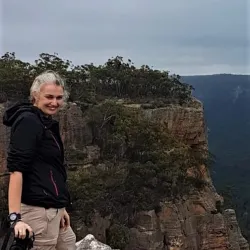Linda Neaves

Content navigation
About
Linda did her undergraduate and PhD at Macquarie University where she studied the population genetics of kangaroos. She then moved to Scotland for a postdoc at the Royal Botanic Garden Edinburgh, where she worked with scientists, conservation practitioners and government organisation to improve the integration of genetic data and information into policy. She briefly returned to Australia, working the Australian Centre for Wildlife Genomics, Australian Museum on the koala genome project and the development of next generation sequencing technologies, where she developed an interest in the application of trace DNA. Following this she undertook a joint postdoc between the Royal Botanic Garden Edinburgh and the Australian Museum during which she investigated of the diet of wild giant panda in China. In 2020, she moved to ANU as a conservation geneticist in Fenner where she works on a range of projects using DNA and genetic tools to address conservation relevant questions.
Affiliations
Research interests
My research uses genomic tools to address a range of species management and conservation based problems for plants and animals, including species identification and discrimination, population structure and history as well as phylogenetics. I am also interested in the development of methods to obtain information from degraded samples, such as environmental DNA, herbarium and museum samples and detection of trace DNA to provide new insights into species ecology and interactions
Monitoring genetic and evolutionary change
There are an ever-increasing number of threats to native wildlife, including increased habitat loss and fragmentation, non-native and invasive species, climate change and increased frequency of extreme conditions, all of which impact on genetic diversity. The detrimental consequences of the loss of genomic variation on persistence and the potential for evolutionary change to facilitate adaptation to changing conditions are widely recognised and form a key aspect of management strategies. However, critical baseline genetic data, particularly in adaptation to environmental change is still lacking for many species and evolutionary change may not be harnessed to its full effect in management. Using a range of approaches we are monitoring the level of genetic diversity and changes in this diversity across a range of groups, primarily mammals and birds across Australia, including several species that have been reintroduced Mulligan’s Flat Woodland Sanctuary such as eastern bettong and eastern quoll.
Understanding trophic interactions between species and tracking change
The conservation and restoration of Australia’s ecosystems requires and understanding of the community composition and the interactions between key taxa. Native faunal assemblages have been disrupted to varying degrees, with many taxa lost before scientific studies, which could have guided restoration, were undertaken. The direct trophic impacts of species can have flow on effects that result in alteration of assemblages and ecological succession and diet can be influenced by a range of factors, including availability, competition and predation risk, habitat fragmentation and urbanisation. However, predicting the direct trophic impacts of a reintroduction is not straightforward. This is because our understanding of ecosystem assemblages and interactions between individual species is limited, particularly for species which have been reintroduced to an area after local extinctions decades or even 100s of years ago. Thus, our understanding of the potential direct impacts of reintroduced species on other species in the ecosystem is limited.
We are investigating the DNA found in scats we are investigating the diet of a range of animals, some of which have been reintroduced at Mulligan’s Flat – Goorooyarroo Nature Reserves and surrounds to understand how these animals may interact and their impacts on the plants and fungi in the reserve. We are also working on using other forms of eDNA – the DNA that all organisms shed into the environment to determine and track which species occur at the site.
